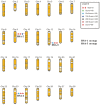High-efficiency production of human serum albumin in the posterior silk glands of transgenic silkworms, Bombyx mori L
- PMID: 29352308
- PMCID: PMC5774803
- DOI: 10.1371/journal.pone.0191507
High-efficiency production of human serum albumin in the posterior silk glands of transgenic silkworms, Bombyx mori L
Abstract
Human serum albumin (HSA) is an important biological preparation with a variety of biological functions in clinical applications. In this study, the mRNA of a fusion transposase derived from the pESNT-PBase plasmid and a pBHSA plasmid containing the HSA gene under the control of a fibroin light chain (FL) promoter were co-injected into fertilized eggs. Fifty-six transgenic silkworm pedigrees expressing theexogenous recombinant HSA (rHSA) in the posterior silk glands (PSGs) with stable inheritance were successfully obtained. The SDS-PAGE and Western blot results confirmed that the rHSA was secreted into the transgenic silkworm cocoon, and the rHSA could be easily extracted with phosphate-buffered saline (PBS). In our research, the isolated highest amount rHSA constituted up to 29.1% of the total soluble protein of the cocoon shell, indicating that the transgenic silkworm produced an average of 17.4 μg/mg of rHSA in the cocoon shell. The production of soluble rHSA in the PSGs by means of generating transgenic silkworms is a novel approach, whereby a large amount of virus-free and functional HSA can be produced through the simple rearing of silkworms.
Conflict of interest statement
Figures




Similar articles
-
Generation of a transgenic silkworm that secretes recombinant proteins in the sericin layer of cocoon: production of recombinant human serum albumin.J Biotechnol. 2007 Feb 20;128(3):531-44. doi: 10.1016/j.jbiotec.2006.10.019. Epub 2006 Nov 17. J Biotechnol. 2007. PMID: 17166611
-
Reducing blood glucose level in TIDM mice by orally administering the silk glands of transgenic hIGF-I silkworms.Biochem Biophys Res Commun. 2011 Jul 15;410(4):721-5. doi: 10.1016/j.bbrc.2011.05.157. Epub 2011 Jun 6. Biochem Biophys Res Commun. 2011. PMID: 21672515
-
Large-scale and cost-effective production of recombinant human serum albumin (rHSA) in transgenic Bombyx mori cocoons.Int J Biol Macromol. 2023 Aug 1;245:125527. doi: 10.1016/j.ijbiomac.2023.125527. Epub 2023 Jun 26. Int J Biol Macromol. 2023. PMID: 37379947
-
Transgenic silkworms that weave recombinant proteins into silk cocoons.Biotechnol Lett. 2011 Apr;33(4):645-54. doi: 10.1007/s10529-010-0498-z. Epub 2010 Dec 24. Biotechnol Lett. 2011. PMID: 21184136 Review.
-
Transgenic modifications of silkworms as a means to obtain therapeutic biomolecules and protein fibers with exceptional properties.Biotechnol Bioeng. 2023 Oct;120(10):2827-2839. doi: 10.1002/bit.28455. Epub 2023 May 27. Biotechnol Bioeng. 2023. PMID: 37243890 Review.
Cited by
-
A silkworm based silk gland bioreactor for high-efficiency production of recombinant human lactoferrin with antibacterial and anti-inflammatory activities.J Biol Eng. 2019 Jul 5;13:61. doi: 10.1186/s13036-019-0186-z. eCollection 2019. J Biol Eng. 2019. PMID: 31312254 Free PMC article.
-
P25 Gene Knockout Contributes to Human Epidermal Growth Factor Production in Transgenic Silkworms.Int J Mol Sci. 2021 Mar 8;22(5):2709. doi: 10.3390/ijms22052709. Int J Mol Sci. 2021. PMID: 33800168 Free PMC article.
References
-
- Cai C, Zhou K, Wu Y, Wu L. Enhanced liver targeting of 5-fluorouracil using galactosylated human serum albumin as a carrier molecule. Journal of Drug Targeting. 2006; 14: 55–61. doi: 10.1080/10611860600613324 - DOI - PubMed
-
- Lamousé-Smith A, Subramanian GM, Fiscella M, Zeuzem S, McHutchison JG. Albinterferon α-2b: a genetic fusion protein for the treatment of chronic hepatitis C. Nature Biotechnology. 2007; 25: 1411–1419. doi: 10.1038/nbt1364 - DOI - PubMed
-
- De Gaudio AR. Therapeutic use of albumin. International Journal of Artificial Organs. 1995; 18: 216–224. - PubMed
-
- Erstad BL. Viral infectivity of albumin and plasma protein fraction. Pharmacotherapy. 1996; 16: 996–1001. - PubMed
Publication types
MeSH terms
Substances
LinkOut - more resources
Full Text Sources
Other Literature Sources

